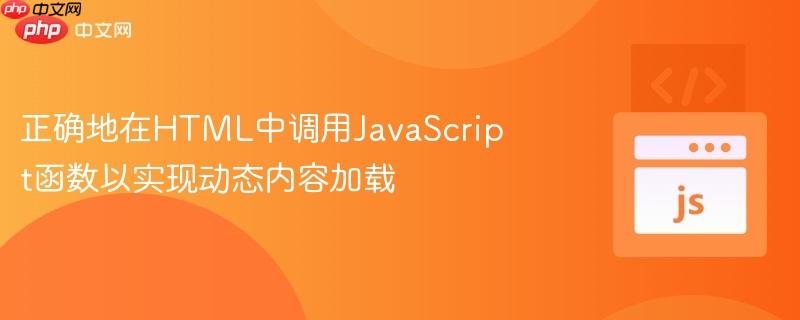
在网页开发中,我们经常需要利用javascript来动态生成或修改html内容。一个常见的需求是在特定html元素加载完成后执行某个javascript函数。然而,直接在所有html标签上使用onload属性来触发javascript函数是一种常见的误解,尤其是在<article>这样的非媒体或非文档根元素上。
HTML规范明确指出,onload属性并非所有HTML元素的全局属性。它主要用于<body>元素(当整个页面及其所有资源加载完成时触发),以及一些特定元素如<img>、<iframe>、<script>等,这些元素在加载外部资源时会触发onload事件。<article>标签仅支持全局属性,而onload并不在其列。因此,尝试在<article id="myarticle" onload="...">中调用JavaScript函数是无效的,浏览器会直接忽略这个属性。
为了在DOM元素准备就绪后安全有效地执行JavaScript函数,我们应该采用以下两种主要策略:
DOMContentLoaded事件在HTML文档被完全加载和解析完成时触发,而无需等待样式表、图片等所有子资源的加载。这是处理DOM操作和初始化JavaScript逻辑的最佳时机。
示例代码:
立即学习“Java免费学习笔记(深入)”;
假设我们有一个JavaScript函数displayArticleContent,它根据传入的元素ID和日期范围来动态更新文章内容:
// 定义一个JavaScript函数,用于动态更新指定ID的文章内容
function displayArticleContent(elementId, startDateStr, endDateStr) {
const targetElement = document.getElementById(elementId);
if (targetElement) {
const startDate = new Date(startDateStr);
const endDate = new Date(endDateStr);
const today = new Date();
let contentHtml = `<h2>文章ID: ${elementId}</h2>`;
contentHtml += `<p>此内容于 <strong>${new Date().toLocaleTimeString()}</strong> 动态加载。</p>`;
if (today >= startDate && today <= endDate) {
contentHtml += `<p>当前日期 (${today.toLocaleDateString()}) 在指定发布范围 <strong>${startDateStr} - ${endDateStr}</strong> 内。</p>`;
} else {
contentHtml += `<p>当前日期 (${today.toLocaleDateString()}) 不在指定发布范围 <strong>${startDateStr} - ${endDateStr}</strong> 内。</p>`;
}
targetElement.innerHTML = contentHtml; // 更新元素内容
} else {
console.error(`错误:未找到ID为 "${elementId}" 的目标元素。`);
}
}
// 使用 DOMContentLoaded 事件确保DOM已完全加载
document.addEventListener('DOMContentLoaded', () => {
console.log('DOM内容已完全加载,开始执行动态内容脚本...');
// 调用函数更新特定文章
displayArticleContent('myarticle-1', '05/19/2023', '06/01/2023');
// 如果有多个动态文章,可以分别调用或遍历
displayArticleContent('myarticle-2', '06/01/2024', '07/01/2024');
});HTML结构:
<!DOCTYPE html>
<html lang="zh-CN">
<head>
<meta charset="UTF-8">
<meta name="viewport" content="width=device-width, initial-scale=1.0">
<title>动态内容加载教程</title>
</head>
<body>
<h1>我的博客文章</h1>
<article id="myarticle-1">
<p>这里的内容将在页面加载后动态更新。</p>
</article>
<article id="myarticle-2">
<p>这是另一篇需要动态加载内容的文章。</p>
</article>
<!-- JavaScript通常放在</body>标签结束之前,或<head>中使用defer属性 -->
<script src="path/to/your/script.js"></script>
<!-- 或者直接在这里写JavaScript代码 -->
</body>
</html>注意事项:
window.onload事件在整个页面(包括所有图片、样式表、脚本等)都加载完成后触发。相比DOMContentLoaded,它等待的时间更长。对于仅涉及DOM操作的场景,DOMContentLoaded通常是更优选择。
示例:
window.onload = function() {
console.log('所有资源(包括图片、样式表)都已加载完成。');
displayArticleContent('myarticle-1', '05/19/2023', '06/01/2023');
};与DOMContentLoaded的区别:
有时,我们可能希望对页面上所有符合特定条件的元素执行操作,而无需为每个元素分配唯一的ID。这可以通过DOM查询方法实现。
示例:使用querySelectorAll和data属性
<article class="dynamic-article" data-start-date="01/01/2024" data-end-date="03/31/2024">
<p>第一篇动态文章。</p>
</article>
<article class="dynamic-article" data-start-date="04/01/2024" data-end-date="06/30/2024">
<p>第二篇动态文章。</p>
</article>document.addEventListener('DOMContentLoaded', () => {
const dynamicArticles = document.querySelectorAll('.dynamic-article');
dynamicArticles.forEach((articleElement, index) => {
// 从data属性中获取日期信息
const startDate = articleElement.dataset.startDate;
const endDate = articleElement.dataset.endDate;
// 为没有ID的元素生成一个临时ID,或者直接操作元素本身
const elementId = articleElement.id || `dynamic-article-${index}`;
articleElement.id = elementId; // 确保有一个ID以便函数能找到它,或直接修改函数接受元素对象
// 调用函数更新内容
displayArticleContent(elementId, startDate, endDate);
});
});在这种情况下,displayArticleContent函数可以修改为直接接受元素对象,而不是ID,以避免动态设置ID的开销:
function displayArticleContentByElement(element, startDateStr, endDateStr) {
if (element) {
const startDate = new Date(startDateStr);
const endDate = new Date(endDateStr);
const today = new Date();
let contentHtml = `<h2>文章 (${element.id || '无ID'})</h2>`;
contentHtml += `<p>此内容于 <strong>${new Date().toLocaleTimeString()}</strong> 动态加载。</p>`;
if (today >= startDate && today <= endDate) {
contentHtml += `<p>当前日期 (${today.toLocaleDateString()}) 在指定发布范围 <strong>${startDateStr} - ${endDateStr}</strong> 内。</p>`;
} else {
contentHtml += `<p>当前日期 (${today.toLocaleDateString()}) 不在指定发布范围 <strong>${startDateStr} - ${endDateStr}</strong> 内。</p>`;
}
element.innerHTML = contentHtml;
} else {
console.error('错误:传入的元素无效。');
}
}
document.addEventListener('DOMContentLoaded', () => {
const dynamicArticles = document.querySelectorAll('.dynamic-article');
dynamicArticles.forEach(articleElement => {
const startDate = articleElement.dataset.startDate;
const endDate = articleElement.dataset.endDate;
displayArticleContentByElement(articleElement, startDate, endDate);
});
});在HTML中正确地调用JavaScript函数以实现动态内容加载,关键在于理解HTML元素的事件属性支持和JavaScript事件生命周期。直接在<article>等非特定元素上使用onload属性是无效的。最推荐的做法是利用document.addEventListener('DOMContentLoaded', ...)来确保JavaScript代码在DOM结构完全可用后执行,从而实现安全、高效的页面动态更新。同时,通过data属性和querySelectorAll,我们可以实现更灵活、更可维护的批量元素处理方案。
以上就是正确地在HTML中调用JavaScript函数以实现动态内容加载的详细内容,更多请关注php中文网其它相关文章!

HTML怎么学习?HTML怎么入门?HTML在哪学?HTML怎么学才快?不用担心,这里为大家提供了HTML速学教程(入门课程),有需要的小伙伴保存下载就能学习啦!

Copyright 2014-2025 https://www.php.cn/ All Rights Reserved | php.cn | 湘ICP备2023035733号